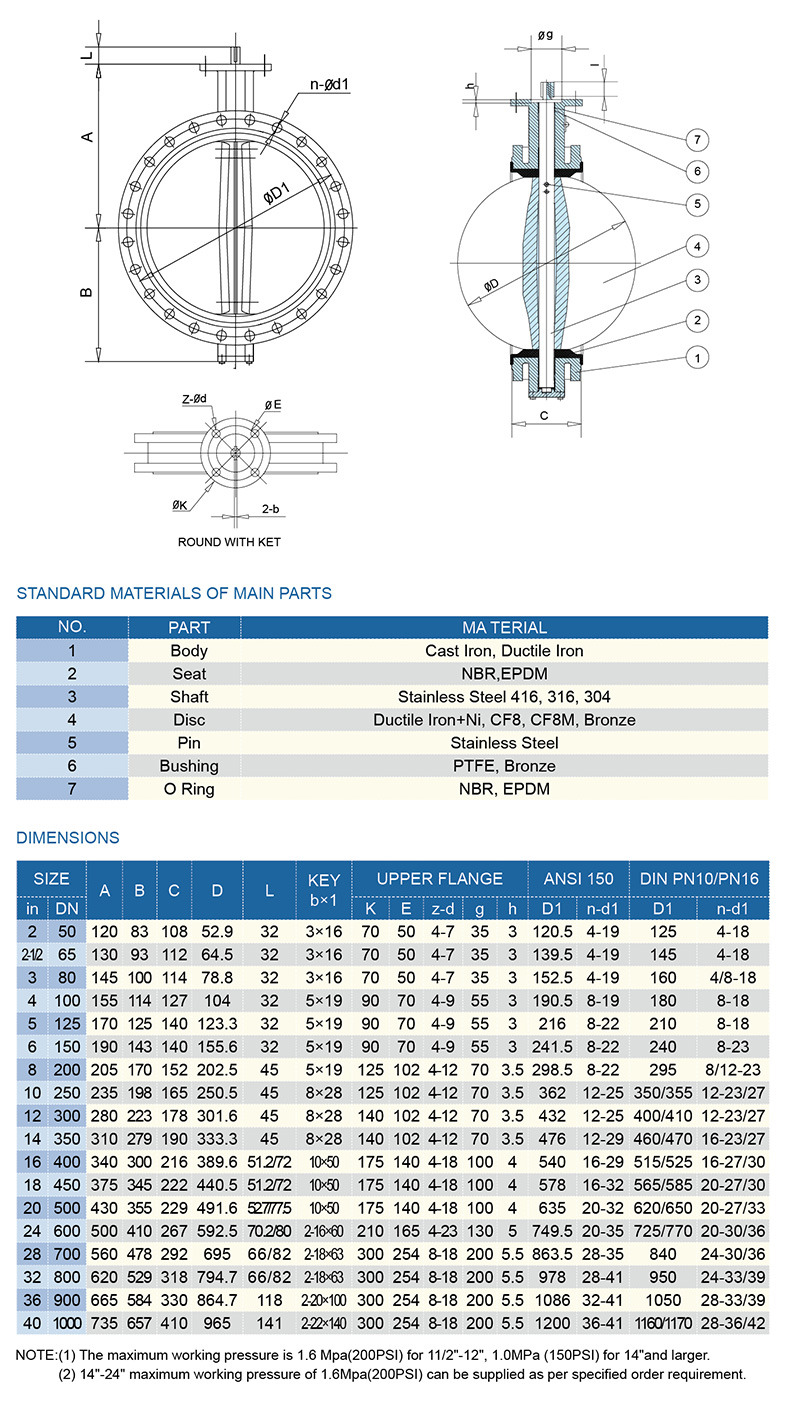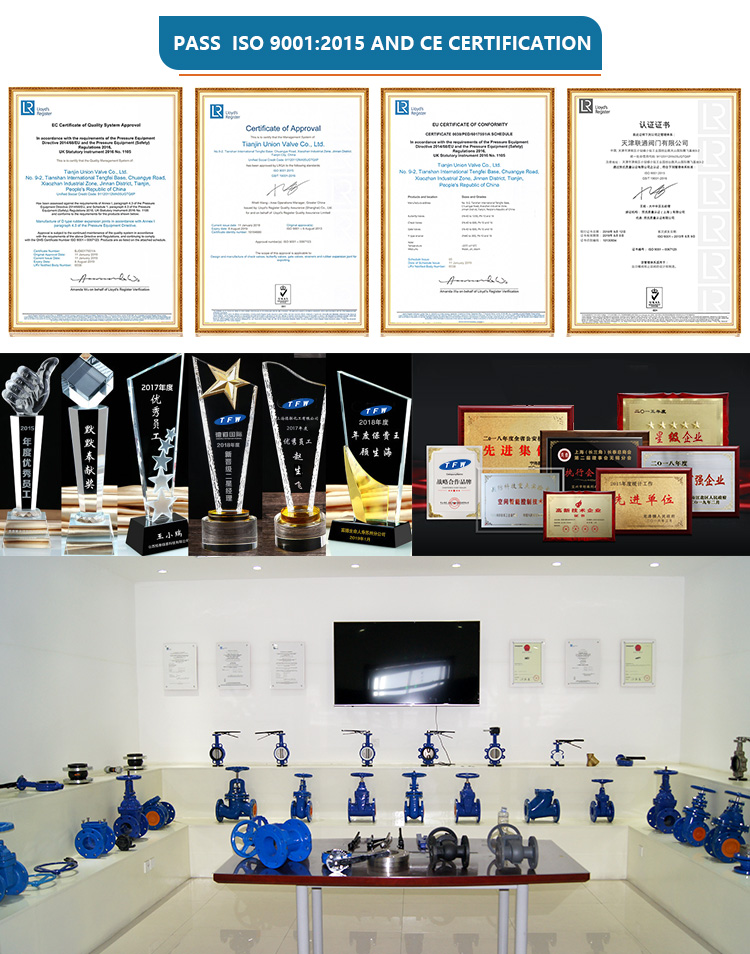- All
- Product Name
- Product Keyword
- Product Model
- Product Summary
- Product Description
- Multi Field Search
English
| Availability: | |
|---|---|
| Quantity: | |
Size: DN50-DN1200 |
Features:
1. Small in size, light in weight, easy installation and maintenance.
2. Simple and compact construction, quick 90 degree on-off operation.
3. Minimized operating torque, energy saving.
4. Flow curve tending to straight line, excellent regulation performance.
5. Long service life, standing the test of tens thousands opening/closing operations.
6. Wide selection of materials, applicable to various medium.
Performance:
Nominal pressue (MPa) | 1.0 | 1.6 | |
Nominal diameter(mm) | 50-2400 | 50-3200 | |
Test pressure | Shell | 1.5 | 2.4 |
(MPa) | Seal | 1.1 | 1.76 |
Applicable temperature | 150 | ||
Applicable medium | Fresh water, Sewage, Sea water, Air, Vapor, Food, Medicine, Oils, Acids, | ||
Operating mode | manual, worm gear, pneumatic, electric, etc. | ||
Standard:
Design & Manufacture | Flange Connection | Face to Face Dimension | Test & Inspection |
MSS SP-67 | DIN PN10/16/25; ANSI B 16.1 | API609 | API 598 |
Material List:
No. | Part Name | Material |
1 | Body | Carbon Steel/Stainless Steel/Cast Iron/Ductile Iron/ Al-Bronze |
2 | Disc | Al-Bronze/CF8M/Ductile iron/WCB |
3 | Seat | EPDM/PEFE/Buna/NBR/Hypalon |
4 | Stem | Carbon Steel/Stainless Steel314/Stainless Steel316 |
5 | Bushing | PTFE/Lubricating |
6 | O ring | EPDM/PEFE/Buna/NBR/Hypalon |
7 | Pin | SS316/SS416/SS304 |



A flange butterfly valve is a type of butterfly valve that uses a flanged connection method.
The structure of the flange butterfly valve is simple, small in size, and lightweight, typically consisting of just a few components. Its working principle is that the butterfly disc rotates inside the cylindrical passage of the valve body, with an angle ranging from 0° to 90°. When rotated to 90°, the valve is in the fully open position. In the completely open position of the flange butterfly valve, the thickness of the butterfly disc is the only resistance to the flow of the medium through the valve body, resulting in a very small pressure drop, and providing excellent flow control characteristics.
Furthermore, the sealing structure of the flange butterfly valve adopts a composite valve seat made of polytetrafluoroethylene, synthetic rubber, and phenolic resin, enhancing the elasticity and strength of the valve. At the same time, the butterfly disc is fully encapsulated with polytetrafluoroethylene, increasing its corrosion resistance. Flange butterfly valves are suitable for temperatures ≤120°C or ≤150°C, and a nominal pressure ≤1.6MPa, used in water supply and drainage, metallurgy, energy systems, and light textile industries, particularly suitable for bidirectional sealing and situations where the valve body is prone to corrosion.
A double flanged butterfly valve with an actuator is a butterfly valve assembly that has flanged connections at both the inlet and outlet sides of the valve body, and includes an actuator mechanism to operate the valve disc or butterfly.
The key components and features are:
Double Flanged Body: The valve body has flanges at both ends to allow connection to mating pipe flanges using bolts and gaskets.
Butterfly Disc: A circular disc or butterfly is mounted on a stem or shaft inside the valve body. Rotating this disc controls the flow through the valve.
Actuator: An actuator, usually pneumatic, hydraulic or electric, is mounted on top of the valve body. It provides the force and motion to rotate the valve stem and position the butterfly disc.
Actuator Mounting: The actuator is securely mounted to the valve body using a mounting bracket or flange.
Position Indicator: Many actuated valves have a position indicator that shows the open/closed status of the valve disc.
Control Accessories: Depending on requirements, actuators may have solenoid valves, positioners, limit switches, etc. for remote operation and monitoring.
The actuator automates the operation of the butterfly valve, allowing it to be opened, closed or modulated from a remote location or control system. This eliminates the need for manual operation and enables precise flow control.
Actuated double flanged butterfly valves are commonly used in industrial processes, power plants, water treatment facilities, and other applications where automatic or remote valve control is required. The actuator type (pneumatic, hydraulic, electric) depends on factors like operating conditions, power availability, and control system requirements.
DN50-DN1200 ,2"-48",2 inch-48 inch
The main difference between a wafer butterfly valve and a flanged butterfly valve lies in the method of installation and the design of the valve body.
It has a thin, circular valve body without flanges on the end connections.
The valve body is sandwiched between two pipe flanges using bolts that go through the outside of the pipe flanges.
The wafer valve body has no bolt holes of its own, making it more compact and lightweight.
Installation requires disassemly of the pipe flanges.
Wafer valves are typically used for smaller pipe sizes (up to around 24 inches).
They are less expensive than flanged valves for the same size.
Flanged Butterfly Valve:
It has a valve body with integral flanges on both the inlet and outlet ends.
The flanges have bolt holes that allow direct bolting of the valve between two pipe flanges using gaskets.
No disassembly of the pipe flanges is required for installation.
Flanged valves are available for a wider range of pipe sizes, including larger diameters.
They are generally more robust and suitable for higher pressure applications compared to wafer valves.
Flanged valves are more expensive than wafer valves of the same size.
In summary, wafer butterfly valves are thinner, lighter, and more compact, making them a cost-effective choice for smaller sizes. Flanged butterfly valves are sturdier, more versatile in terms of size and pressure rating, but also more expensive and require more space for installation.
Size: DN50-DN1200 |
Features:
1. Small in size, light in weight, easy installation and maintenance.
2. Simple and compact construction, quick 90 degree on-off operation.
3. Minimized operating torque, energy saving.
4. Flow curve tending to straight line, excellent regulation performance.
5. Long service life, standing the test of tens thousands opening/closing operations.
6. Wide selection of materials, applicable to various medium.
Performance:
Nominal pressue (MPa) | 1.0 | 1.6 | |
Nominal diameter(mm) | 50-2400 | 50-3200 | |
Test pressure | Shell | 1.5 | 2.4 |
(MPa) | Seal | 1.1 | 1.76 |
Applicable temperature | 150 | ||
Applicable medium | Fresh water, Sewage, Sea water, Air, Vapor, Food, Medicine, Oils, Acids, | ||
Operating mode | manual, worm gear, pneumatic, electric, etc. | ||
Standard:
Design & Manufacture | Flange Connection | Face to Face Dimension | Test & Inspection |
MSS SP-67 | DIN PN10/16/25; ANSI B 16.1 | API609 | API 598 |
Material List:
No. | Part Name | Material |
1 | Body | Carbon Steel/Stainless Steel/Cast Iron/Ductile Iron/ Al-Bronze |
2 | Disc | Al-Bronze/CF8M/Ductile iron/WCB |
3 | Seat | EPDM/PEFE/Buna/NBR/Hypalon |
4 | Stem | Carbon Steel/Stainless Steel314/Stainless Steel316 |
5 | Bushing | PTFE/Lubricating |
6 | O ring | EPDM/PEFE/Buna/NBR/Hypalon |
7 | Pin | SS316/SS416/SS304 |



A flange butterfly valve is a type of butterfly valve that uses a flanged connection method.
The structure of the flange butterfly valve is simple, small in size, and lightweight, typically consisting of just a few components. Its working principle is that the butterfly disc rotates inside the cylindrical passage of the valve body, with an angle ranging from 0° to 90°. When rotated to 90°, the valve is in the fully open position. In the completely open position of the flange butterfly valve, the thickness of the butterfly disc is the only resistance to the flow of the medium through the valve body, resulting in a very small pressure drop, and providing excellent flow control characteristics.
Furthermore, the sealing structure of the flange butterfly valve adopts a composite valve seat made of polytetrafluoroethylene, synthetic rubber, and phenolic resin, enhancing the elasticity and strength of the valve. At the same time, the butterfly disc is fully encapsulated with polytetrafluoroethylene, increasing its corrosion resistance. Flange butterfly valves are suitable for temperatures ≤120°C or ≤150°C, and a nominal pressure ≤1.6MPa, used in water supply and drainage, metallurgy, energy systems, and light textile industries, particularly suitable for bidirectional sealing and situations where the valve body is prone to corrosion.
A double flanged butterfly valve with an actuator is a butterfly valve assembly that has flanged connections at both the inlet and outlet sides of the valve body, and includes an actuator mechanism to operate the valve disc or butterfly.
The key components and features are:
Double Flanged Body: The valve body has flanges at both ends to allow connection to mating pipe flanges using bolts and gaskets.
Butterfly Disc: A circular disc or butterfly is mounted on a stem or shaft inside the valve body. Rotating this disc controls the flow through the valve.
Actuator: An actuator, usually pneumatic, hydraulic or electric, is mounted on top of the valve body. It provides the force and motion to rotate the valve stem and position the butterfly disc.
Actuator Mounting: The actuator is securely mounted to the valve body using a mounting bracket or flange.
Position Indicator: Many actuated valves have a position indicator that shows the open/closed status of the valve disc.
Control Accessories: Depending on requirements, actuators may have solenoid valves, positioners, limit switches, etc. for remote operation and monitoring.
The actuator automates the operation of the butterfly valve, allowing it to be opened, closed or modulated from a remote location or control system. This eliminates the need for manual operation and enables precise flow control.
Actuated double flanged butterfly valves are commonly used in industrial processes, power plants, water treatment facilities, and other applications where automatic or remote valve control is required. The actuator type (pneumatic, hydraulic, electric) depends on factors like operating conditions, power availability, and control system requirements.
DN50-DN1200 ,2"-48",2 inch-48 inch
The main difference between a wafer butterfly valve and a flanged butterfly valve lies in the method of installation and the design of the valve body.
It has a thin, circular valve body without flanges on the end connections.
The valve body is sandwiched between two pipe flanges using bolts that go through the outside of the pipe flanges.
The wafer valve body has no bolt holes of its own, making it more compact and lightweight.
Installation requires disassemly of the pipe flanges.
Wafer valves are typically used for smaller pipe sizes (up to around 24 inches).
They are less expensive than flanged valves for the same size.
Flanged Butterfly Valve:
It has a valve body with integral flanges on both the inlet and outlet ends.
The flanges have bolt holes that allow direct bolting of the valve between two pipe flanges using gaskets.
No disassembly of the pipe flanges is required for installation.
Flanged valves are available for a wider range of pipe sizes, including larger diameters.
They are generally more robust and suitable for higher pressure applications compared to wafer valves.
Flanged valves are more expensive than wafer valves of the same size.
In summary, wafer butterfly valves are thinner, lighter, and more compact, making them a cost-effective choice for smaller sizes. Flanged butterfly valves are sturdier, more versatile in terms of size and pressure rating, but also more expensive and require more space for installation.
Company Name: Tianjin Tangfa Watts Valve Co., Ltd.
Contact Person: Mr. jack wang (General Manager)
+86 22 66224148
+86 22 25291233
RM8401-3,TIANHE TECHNICAL ZONE,BINHAI NEW AREA,TIANJIN CITY,CHINA